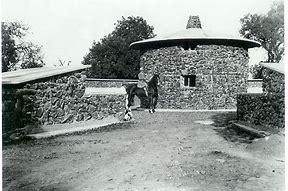Beauty Ranch
I am rebuilding worn-out hillside lands that were worked out and destroyed by our wasteful California pioneer farmers. I am not using commercial fertilizer. I believe the soil is our one indestructible asset, and by green manures, nitrogen-gathering cover crops,proper tillage and draining, I am getting results which the Chinese have demonstrated for forty centuries." --Jack London

London approached his Beauty Ranch as he did with everything in life: with determination, persistence, and research. He studied and marked up agricultural bulletins from the University of California at Davis. He consulted with nearby plant developer Luther Burbank. In addition to exploring the best way to build healthy soils, he investigated the newest methods of animal husbandry to selectively breed livestock. Assisting him was his step-sister Eliza Shepard, who was in charge of overseeing ranch activities. She noted his goal was "to develop a model farm: one of the best all-around ranches in the state, combining a stock ranch, fruit, grain, vegetables, vinyard, and the like." Charmian London's main interest on the ranch was animal husbandry, along with the care of the horses.
Another organizing principle was self-sufficiency. He envisioned a community where most needs were met on site. That explains the breadth of his farming and the introduction of specialized structures, such as a blacksmith shop and a manure pit. Jack London developed his manure dryer with a concrete floor and a roof so that the manure would retain its richness for use as fertilizer. London once told a farm magazine reporter, "I adopted the policy of taking nothing off the ranch. I raised stuff and fed it to the stock. I got the first manure spreader ever seen [here] and so put fertilizer back on the land before its strength had leaked out." The stone farm buildings, the Manure Dryer, the Stallion Barn were built by Italian stonemasons London had hired. The Sherry Barn, part of the old winery, had been built by Chinese workman.
He also considered the workers, whom he believed should not have unnecessary labor. In one creative move, he designed a circular pig housing. Jack's beautiful and highly practical Pig Palace was built in 1915. It drew wide attention for its unique design and efficiency. The rounded structure in the middle was the feed room. Each sow and her brood enjoyed their own "apartment" with a sun porch in the front, which served as their dining room, and an outside run in the back. One man could easily care for over two hundred Jersey Duroc hogs. The opening of one valve filled all the water troughs in each suite. Other farmers laughed at his choice, yet he later noted his pigs did not suffer the diseases of others.

Jack London had built the first concrete block silos in California and filled them with silage grown on his and neighboring ranches. He had plans for several more silos, but only built two. Over forty feet tall - they stand today like gray sentinels watching over the ranch. Some areas on the ranch were swampy and crops would not grow there. London had drainage ditches dug and cement pipes installed and back-filled with sand. The pipes were porous and the water filtered through the sand into the porous pipes and was directed to other areas on the ranch where water was needed. After the waterlogged areas were drained, corn was planted and successfully grown. The corn was cut and put into the silos he had built.
Another feature of the ranch was opportunities for leisure, for both guests and workers. "My first big dam on the place is just finished so that on these poor, old, worked-out, eroded hillsides I shall be able to harvest two crops a year and turn one crop under; in place of the old meagre crop that could be taken off only once in several years."The lake was formed by the building of a stone dam in the hills above the ranch fields. It was kept full by a pipe line bringing water from Graham Creek.
Early in January 1910 London ordered 15,000 C. tereticornis eucalyptus trees for his ranch. In February the planting began on the La Motte section. The planting of eucalyptus trees wasn't a rash move on Jack's part. The La Motte place was ideal for the purpose, being unsuitable for anything else except pasture land. Before ordering the trees, he studied everything he could find about the viability of the eucalyptus as a cash crop. Certainly he didn't fall under the spell of the eucalyptus promoters. He checked every government bulletin on the subject and went up to the University of California at Davis to talk to with the agricultural experts there. Every possible piece of information was digested. When it turned out that the eucalyptus tree was worthless, the critics berated London for foolishly planting them, forgetting to mention that nobody knew of their uselessness at the time. Actually, a careful study reveals that Jack London was an excellent businessman, but an unlucky investor.
London died before the ranch could develop fully. His successes included the food needed for his family, guests, and workers; the vinyard; awards in animal husbandry at the annual California State Fair.
Visit the Beauty Ranch and enjoy all the sites described here: Jack London State Historic Park.
--Dave Hartzell

